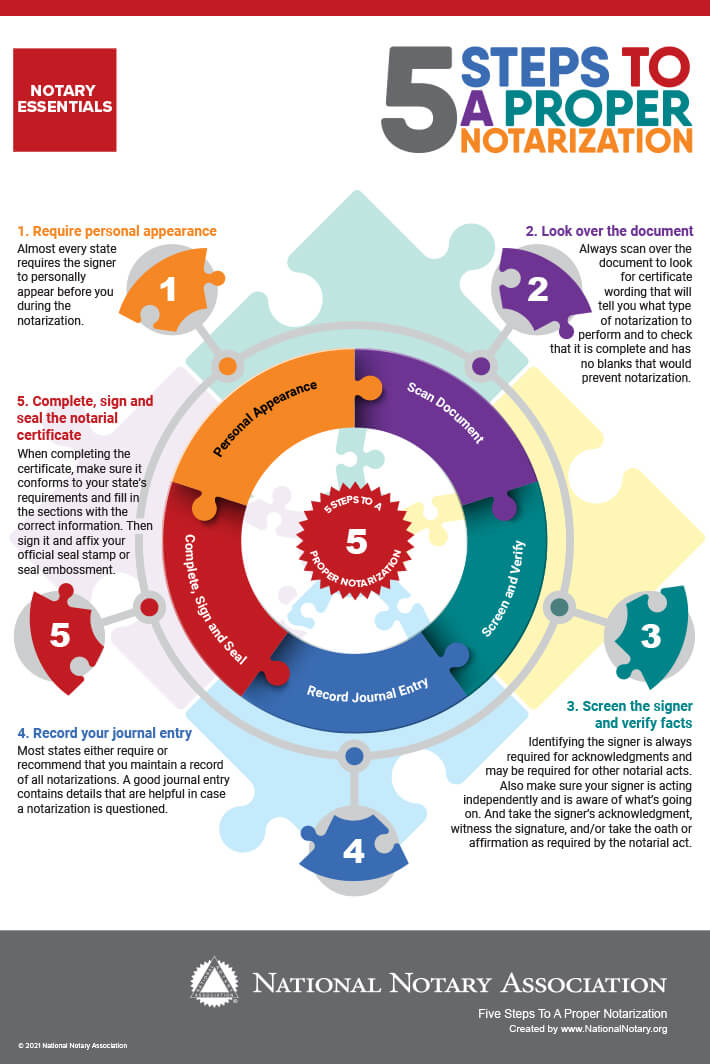what needs to be on a letter thats being notorized
Updated 2-23-22. At that place are few states that give new Notaries applied tips how to notarize a document.Even states that have mandatory education requirements for commission applicants focus more on Notary police than Notary practice.

To help the new Notaries in our community, here are 5 steps to a proper notarization:
Footstep 1: Require Personal Advent
Nearly every state requires the signer to personally announced earlier you during the notarization. That's crucial because it helps protect your signer, your employer, anyone relying on the notarization and you against potential fraud and liability.
Personal appearance allows you to consummate other steps in a proper notarization.
A number of states now permit Notaries to perform notarizations using audio and video conferencing applied science — via remote online notarization.
Step two: Bank check Over The Document
You should always check over the document for a number of important reasons:
- To look for certificate diction that will tell you what blazon of notarization to perform.
- To review the document wording to brand sure it contains all the elements a Notary document should have and that it conforms to the requirements of your state.
- To bank check for bare spaces. Some states mandate there are no blanks on a document and other states just strongly recommend it. Blank documents can exist contradistinct later in an attempt to commit fraud.
- Exist sure to enter the date the notarization took place in the certificate diction.
- To verify that the proper name on the ID supports the name in the document.
Scanning the document does not mean reading it for its details. You should but glance over it sufficiently to get the data you need.
Step three: Carefully Identify The Signer
Properly verifying your signer's identity is the essential duty of every Notary. Every land provides some direction equally to how to identify your signer, and in that location are 3 general methods:
- Personal knowledge, which ways that yous personally know the signer.
- Identity documents, such every bit driver'due south licenses, passports and other authorities-issued IDs.
- Credible identifying witnesses who know the signer and tin vouch for his or her identity.
California does not allow Notaries to rely on personal knowledge to identify signers. Instead, California Notaries must rely either on one of the forms of signer ID permitted by land law, or apparent identifying witnesses if the signer lacks other forms of acceptable identification.
Identifying the signer is always required when you are taking an acknowledgment of a signature and may be required when you perform a jurat, verification upon oath or affirmation or affidavit as well; information technology'south as well recommended when y'all certify a copy.
At this point, make sure your signer is acting of their free will and is aware of what's going on. You lot tin exercise this with small talk and basic questions. When it comes to a signer's awareness, it's recommended that y'all simply make a layperson's judgment nigh the signer'due south ability to understand what is happening. Some states, such every bit Florida, specifically prohibit notarizing if the signer appears mentally incapable of understanding the document. Texas authorizes Notaries to refuse a notarization if the signer appears under coercion, the Notary has reason to believe the document may be used for an illegal purpose or the signer does non understand the document, or if the Notary is not familiar with the type of notarization requested.
Then take the signer's acknowledgment, witness the signature, and/or take the oath or affidavit as required by the notarial deed.
Step 4: Record Your Periodical Entry
Most states either crave or recommend Notaries maintain a record of all notarizations. A practiced Notary journal entry contains details of the notarization that are helpful in example a certificate or notarization is called into question.
Information technology's generally a proficient idea to complete your journal entry before the notarization so yous can make sure to collect all the necessary elements of the tape, including your signer's signature.
Step 5: Consummate The Notarial Document
If the document does non contain certificate wording, ask your signer what type of notarization is required and then attach a split up, or loose, certificate. Many signers do not know what blazon of notarization they need then you may describe the unlike types, but yous may not make the decision for the signer unless you lot are a licensed attorney. If your signer is still uncertain, he or she should contact the issuing or receiving agency for instructions.
When completing the document, make certain all the details are correct. For case, the venue — or location of the notarization, indicated by the words "State of … Canton of …" — should be where you performed the notarization, not where the document was prepared or will exist filed.
Finally, take care to sign and braze your seal properly. You should always sign exactly as your name appears on your committee. Your seal should be close to your signature but should not overlap any diction. The goal is to make everything legible. If yous are in a land that does non require you to use a seal, you may need to add your name and commission information in other spaces below your signature.
A Terminal Notation: Never Give Advice
Many signers will ask you for advice or assist regarding their certificate. Unless you are an attorney, you should always say no considering it would be the unauthorized practice of law, and yous could be held liable.
You can learn about your state'south requirements for a notarization from your state's Notary handbook, website or statutes, or the U.Due south. Notary Reference Transmission, which is a member benefit. The NNA'south Notary Essentials eLearning course guides you through your state's ID rules equally well as identification best practices.
Michael Lewis is Managing Editor of member publications for the National Notary Association.
caringtonevia1960.blogspot.com
Source: https://www.nationalnotary.org/notary-bulletin/blog/2015/04/5-steps-proper-notarization